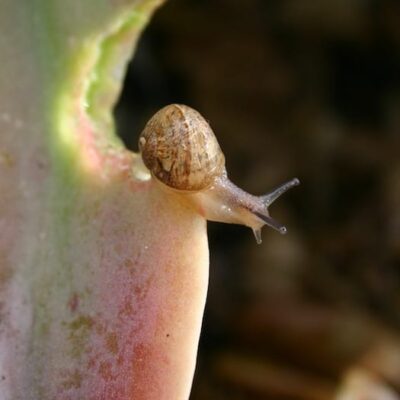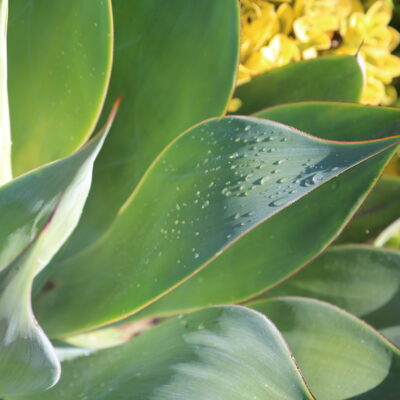It really is this simple ~
Aim to keep soil about as moist as a wrung-out sponge. Watering about once a week in summer and once a month in winter should do it. Water thoroughly to soak the roots and flush salts. Let soil go nearly (not completely) dry between waterings.
An accidental overwatering during warm, dry weather won't harm most succulents providing the soil is fast-draining.
It's not water you need to worry about, it's rot
Roots that get more water than they can handle are are at risk of rotting. Rot starts in the roots and moves upward, into the vital core of the plant. This darkens the tissues, but often the only outward sign of rot is that leaves fall off. By then it's too late.
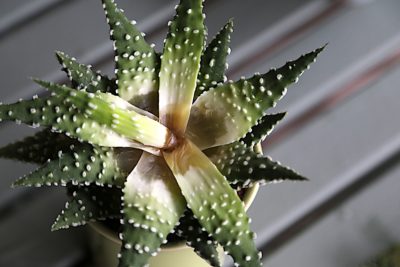
I'd forgotten this haworthia was in a nondraining container. It was fine for over a year until, absentmindedly, I soaked it.
The more rotund the succulent or the fleshier its leaves, the more water it stores in its tissues and the less its roots need (or can tolerate). Cacti, for example, tend to be less tolerant of overwatering than smooth-leaved succulents like echeverias.
The greater the risk of rot, the greater the need for soil that drains rapidly. If a vulnerable succulent is in a pot or in the ground, amend the soil with pumice to absorb excess moisture.
Learn more about the optimal soil mix for succulents.
Enlist gravity to help with drainage. The more susceptible an in-ground succulent is to rotting from excess moisture (like a barrel cactus), the higher it should be planted---ideally on a slope or atop a berm.
When watering a potted succulent, pour until water flows out the bottom. Get rid of pot saucers lest roots sit in water.
See my video, Why Succulents Rot and How to Prevent It (2:01)
"Drench, drain and dry?"
Not exactly. Although succulent “experts” may advise letting soil dry completely, it makes sense that if roots desiccate, growth ceases. A succulent may grow new roots, but dead roots that remain in the soil may rot when it's drenched again. Rotten roots can harbor pathogens that spread to healthy tissue.
Just tell me exactly when to water and how much!
- Have they lost their sheen?
- Are there wrinkles that suggest withering?
- Are they dormant (would you try to make a sleeping pet drink)?
- Has it been hot? Cold? Wet? Dry?
- Is the humidity low or high?
- Is the plant in sun or shade?
- When you insert a wood chopstick into the pot, does it come out with soil clinging to it?
- How large is the plant and/or pot? (Large pots hold more soil and therefore more moisture. Large succulents hold more moisture, too. Small plants---and pots---dry out much faster.)
- What kind of succulent is it? (Agaves need less water than, say, sedums.)
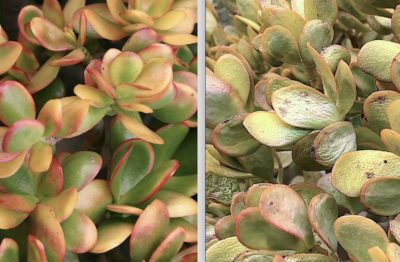
Normal and desiccated 'Sunset' jade. (It survived.)
Is it OK to not water succulents?
No! Just because succulents can live off their leaves doesn't mean they won't die without water. Succulents simply last longer without it than other plants. Succulents do appreciate water and look best if given it regularly...up to a point.
In their native habitats, succulents look truly ratty during times of drought. And in nature or in your garden, succulents that are not well established or go too long without water may not survive.
They love nothing so much as rainwater. On the other hand, succulents dislike nothing so much as being cold and wet.
Neutralize alkalinity
The proper pH for succulents is approximately 5.5 to 6.5 (slightly acidic). City water tends to be alkaline, which can inhibit a plant's ability to take up nutrients, leading to less vigorous growth and yellowing.
Succulent expert Ernesto Sandoval, manager of UC Davis' botanical conservatory, advises that if you live in an area with water that has a high mineral content (typical of San Diego), add 2 tablespoons of vinegar per gallon of water. If your region's water is low in minerals (typical of his area), add one T per gallon.

A water pH meter ("pen") is 6 inches.
Uncertain? Get a pH meter. At about $12, it's worth it for peace of mind. And for a gentler alternative to vinegar, use citric acid (granular; about $15 for a 2-pound bag). (Affiliate links.)
Rain water is naturally acidic. Collect it in buckets and use it to water succulents that are not out in the open.
Dealing With Too Much Rain
Succulents do best in areas of winter rainfall that falls intermittently and doesn't exceed 20 inches a year (of course there are exceptions).
Here are some steps to take when rain threatens to be excessive:
- Move potted succulents beneath your home’s eaves.
- Place patio umbrellas with concrete bases for stability in the garden to keep rain from soaking your in-ground succulents.
- Channel runoff away from garden beds.
- Move and replant succulents if they're in low-lying areas where water puddles.
- Topdress the soil around the plants with several inches of pumice to absorb excess moisture.
See my videos, Why Rain is Good for Potted Succulents (0:53); Post-Rain Must-Do’s for Succulent Gardens (3:51), and The Squish Test for Succulents (3:53).
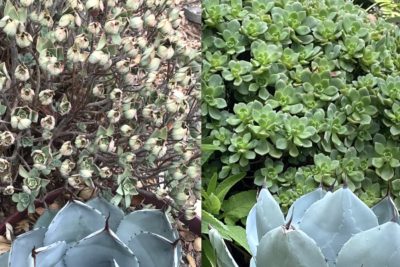
Aeonium haworthii before winter rains and after
Do succulents need drainage? Not necessarily!
How to water succulents in non-draining containers
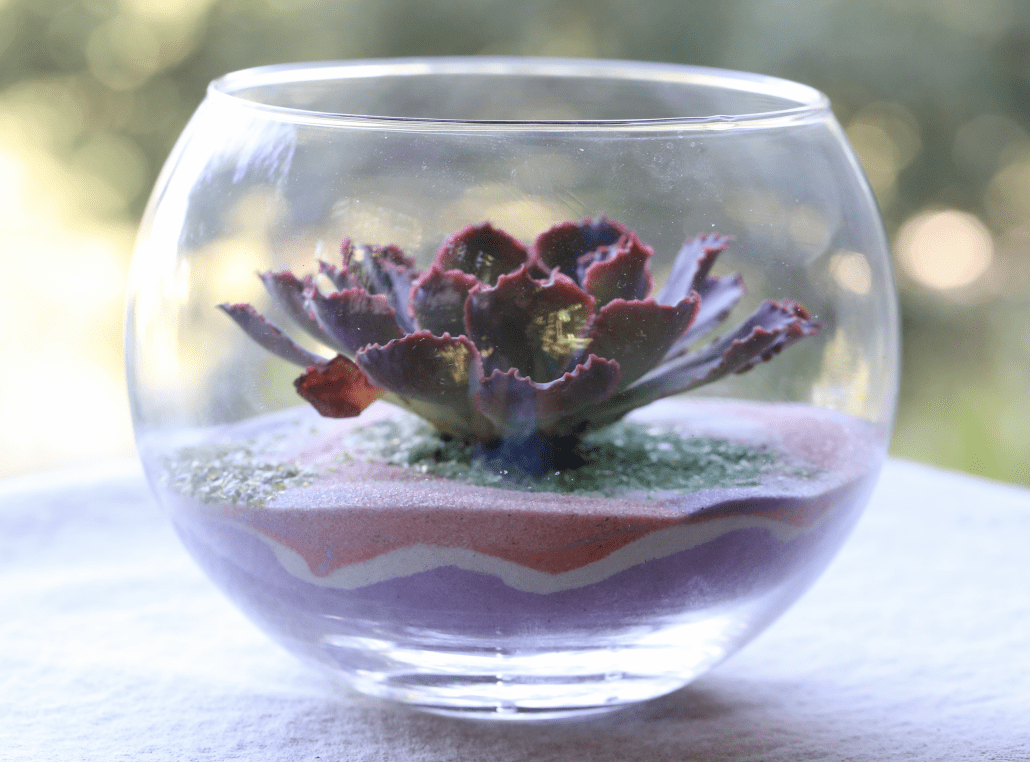
Don't assume that a pot must have a drain hole in order for succulents to be healthy and happy. I know this is counterintuitive...but when you read why, you'll see it makes sense.
It’s not drainage that’s important so much as avoiding root and stem rot, which succulents are prone to if they sit in water. Remember, when given less water than is optimal, they draw on moisture stored in their leaves---the very definition of a succulent.
Underwatered succulents tend to grow very little, which is a good thing because they don’t outgrow the container. You could never do this with woody plants, which when given too little water, dry out and die.
I water terrarium succulents by dribbling water onto their centers or inserting a medicine dropper full of water at each one's base. As soon as I see through the glass at the bottom that the sand is moist, I stop.
Surprisingly, succulents in nondraining containers can last as long or longer than those in containers with holes.
DO NOT add a layer of pebbles or activated charcoal to the bottom of a nondraining container, assuming that this "provides drainage." Water that pools at the bottom of a planted bowl becomes a microbial soup that leads to rot. It's OK to add pumice to soil or sand to help absorb excess water, but don't assume that it "provides drainage" either.
Remember, the point isn't to provide drainage, but to water the plants so minimally that it isn't needed.
A member of the Succulent Dreamers Facebook group summed it up:

For more about growing succulents in nondraining containers, see my videos, Succulents in Silver (3:58) and Succulent Desk Buddies, DIY (4:15).
Resources
Articles
12 Mistakes Beginners Make with Succulents
A smart succulent parent learns what may be expensive to fix and cause prized plants to look dreadful, and what might even do them in.
How to Water Succulents in Summer
Although they may survive without irrigation during the heat of summer, they’re unlikely to be lush and healthy.
No-Water Succulents for Southern California Gardens
Certain readily available succulents not only get by on rainfall alone, they’ll grow in nutrient-poor soil and can handle searing sun and frost.
Videos
Succulent Desk Buddies, DIY (4:15) - Growing succulents in non-draining containers
Why Rain is Good for Potted Succulents (0:53)
Post-Rain Must-Do’s for Succulent Gardens (3:51)
Related info on this site
Prepare Your Succulents for Rainstorms
During rainy weather, succulents, which come from arid climates, may rot. Stems or trunks turn squishy and collapse. It may be possible to take cuttings from healthy top growth and restart the plants—as I did after one rainy winter with aeoniums. Fortunately, the rest of my succulents came through fine, despite double normal rainfall. After…
How Rain Benefits Succulents
Here’s how rain benefits succulents: It provides dissolved minerals and washes away dust that inhibits photosynthesis; it dilutes and flushes salts and harmful chemicals that have built up in the soil from tap water; and it provides nitrogen essential to growth,

